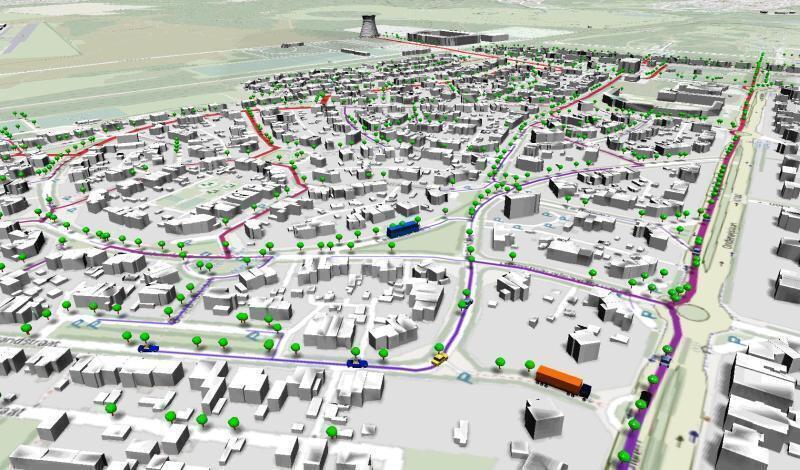EnergyVille develops two optimisation tools for district heating networks
In the search for new technologies for a carbon-free future, much attention is given to electrification and transportation. Heat is still often overlooked, despite accounting for more than 60% of our energy needs. At EnergyVille, thermal systems, particularly district heating networks, are an important focus of research. Here, you can read more about two technologies that optimise the design and operation of district heating networks, developed by EnergyVille.
PATHOPT
PATHOPT is an optimalisation toolbox for the automatic design of thermal networks where the optimal network lay-out is decided based on specific geographic information.
The complexity of the design of district heating networks
Heat is typically supplied by polluting sources such as oil and gas, which poses a significant challenge in our battle against climate change. But how can we heat our buildings without emitting CO2? District heating networks provide a climate-friendly alternative. To explain how they work, imagine a geothermal plant that generates heat located outside your city. But how do you transport that distant heat to the end user? This is achieved by distributing hot water through a large pipeline network to neighborhoods where it can be used by local heating systems.
Currently, there is a substantial untapped potential for utilizing waste heat from sources like large data centers or refrigerated warehouses. To fully harness the potential of this waste heat, along with other renewable sources like thermal or geothermal installations, it is necessary to expand the scale of district heating networks. However, this expansion makes the design very complex and challenging to do manually. PATHOPT addresses this problem.
The operation of the PATHOPT-software
The PATHOPT software designs and improves district heating systems through optimisation and automation of the process. This enables fast, cost-effective, and efficient designs that optimise the connection between buildings and heat sources and accurately plan the sizing of sustainable heat plants.
PATHOPT provides data:
- Automatically, quickly, and accurately.
- Based on geographical input.
- Down to the city level.
- With economic and energy-related output objectives.
- From multiple heat production sources.
With minimal input of the geographical location and preferably input of both the characteristics of the production facility (location, capacity & temperature levels, and heat costs) and the characteristics of the consumer (location, required minimum temperature, and heat demand), the PATHOPT tool delivers the following output:
- Pipeline locations and dimensions.
- Thermohydraulic information, such as temperature and pressure at each location.
- Economic considerations such as CAPEX, OPEX, and revenues.

STORM District Energy Controller
The STORM District Energy Controller is a software technology that increases the energy efficiency of both existing and new district heating systems.

How does the STORM District Energy Controller work?
The STORM controller utilizes the flexibility present in the thermal capacity of connected buildings to optimise production and distribution within the network. Buildings contain a significant amount of thermal mass, such as concrete and furniture. By “activating” this thermal mass, meaning heating or cooling it by less than 1°C, a substantial amount of energy can be stored or utilized. In this way, buildings act as virtual storage without compromising indoor comfort boundaries or causing noticeable disruptions during normal operation. This flexibility is leveraged to benefit the network or energy production facility, making them more efficient and sustainable.
Three business strategies
The STORM controller employs three business strategies. Firstly, it can flatten peaks in the network’s power demand (peak shaving) to reduce the use of expensive (fossil fuel) peak capacity. Additionally, the controller can align the thermal heat demand of buildings with electricity prices (market interaction). For heat pumps, the STORM controller shifts the heat demand to coincide with off-peak electricity prices, while for cogeneration units, it responds to high electricity prices. Lastly, the controller optimizes heat exchange between different buildings in a network (cell balancing). These strategies can be applied separately or in combination within the district heating system.
Technology proven in STORM demo sites
The STORM District Energy Controller was tested and implemented in district heating systems in Mijnwater BV in Heerlen, the Netherlands, and Rottne in Växjö, Sweden, serving as demonstrations in the H2020 STORM project. Tests to flatten peak demand at the Swedish demo site in Rottne resulted in an average long-term peak reduction of 12.75% compared to the reference scenario without the STORM District Energy Controller. Additionally, even in months with low heat demand, a reduction of up to 57% in peak heat demand was achieved.
The cell balancing strategy was tested at the Dutch Mijnwater demo site. The controller successfully reduced the flow rate in the transmission line throughout the entire test period without jeopardizing energy supply to consumers. For peak shaving, a potential of 17.3% was achieved. Moreover, the capacity of the district heating network could be improved by 42.1%, enabling an additional 48,200 residential equivalents to connect to the existing network.
Each of the demo sites achieved a CO2 emission reduction of approximately 11,000 tons per year, equivalent to the emissions of around 1,400 households. Thanks to its diverse range of applications, the STORM District Energy Controller has significant market potential.
New functionalities
The STORM District Energy Controller Peak Shaving is a market-integrable technology for solution providers, but additional control functions are also under development. These new functionalities will include the ability to detect and diagnose underperforming substations within the network.